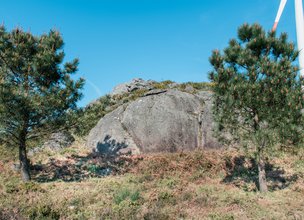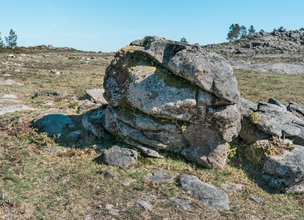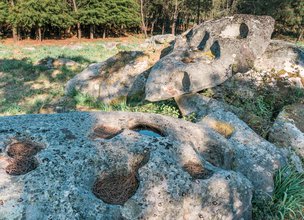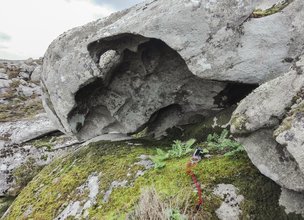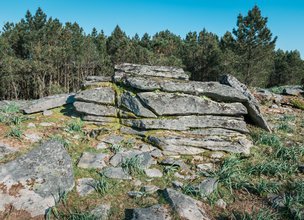Granitic landforms.
Weathering is the set of physical and chemical processes that affect rocks when they are under the action of water, air, temperature variation, and living beings. As a consequence, the minerals, colour and cohesion of rocks change. In granites, weathering is crucial to the development of landforms that might present different shapes and sizes.
The sub-orthogonal and/or sub-horizontal network of fractures usually present in granitic rocks are the main factor responsible for their weathering (esq. A and Fig. 1). Fractures lead to the partitioning of rocks into blocks and facilitate water circulation, thus favouring its weathering and erosion.
Weathering progresses in depth and rocks are progressively transformed into a decomposed and friable material called saprolite, which surrounds round blocks of non-weathered rock.
Depending on their size, granite landforms are usually classified into three major groups: megalandforms (with at least 100 meters); meso-landforms (with dimension between 1 and 100 meters), and micro-landforms (usually inferior to 1 meter). Mega-landforms, such as inselberg or bornhardt, are not found in this LNM; however, it is possible to see meso-landforms such as blocks, tors and nubbins.
Rounded blocks or balls become exposed at the surface when the upper weathered material is eroded. These balls can remain in situ or be transported to another place. Granite balls continue to be weathered at the surface. In this LNM, granite blocks at the surface are only slightly rounded; it is more frequent to find blocks with irregular shapes associated with sub-horizontal fractures (Fig. 2).
Despite the occurrence of meso-landforms in the LNM, micro-landforms predominate, namely pias, tafoni and pseudobedding. They appear in the two main granite facies of the LNM, which might indicate that the chemical nature of these granites is more important than their texture when considering the origin of micro-landforms.
Pias are very common in the granitic landscape of the Iberian Peninsula. They are small closed depressions, usually circular, with centimetres or decimetres, which appear in flat or slightly leaning rocky surfaces (Fig. 3).
The formation of pias has been discussed for some time but it is consensual that their origin is related to chemical weathering. Some authors think that they may form at the surface when the accumulation of water in small cavities leads to the formation of pias through chemical and physical processes. Another hypothesis is that pias may have a complex endogenous origin related to the concentration of tension in specific points of the granite massif during its emplacement.
Tafoni (plural for tafone, an Italian word which means window) are honeycombed hollow forms existing in the walls and bottom surfaces of granite blocks (Fig. 4). Their occurrence and spatial distribution are somehow intriguing, with some (rare) blocks presenting tafoni structure existing side by side with others that do not have it, despite their chemical and structural composition being similar. Such as in the case of pias, the origin of tafoni is controversial: some authors advocate that they may be formed at the surface while others maintain that their formation began in depth in a process similar to that of pias.
Pseudobedding refers to the development of fractures parallel to the topographic surface giving a stratified aspect (such as in sedimentary rocks) to granites (Fig. 5). This process is related to load relief when granites become nearer the surface. The fractures are usually centimetres or decimetres thick, and are a significant contribution to lessen the mechanical resistance of rocks and thus favouring superficial rock movements along slopes.
In the LNM, it is possible to see some granite blocks where their upper part is more prominent than the base (Fig. 6). These landforms, called pedestal blocks, are associated with the process of pseudobedding: they originate when weathering and erosion are stronger at the bottom of pseudobedded blocks (Carvalhido, 2012).
References:
Carvalhido (2012). O Litoral Norte de Portugal (Minho-Neiva): evolução paleoambiental quaternária e proposta de conservação do património geomorfológico. Tese de Doutoramento, Universidade do Minho, 564 p.
Pereira, P; Henriques, R.; Brilha, J. & Pereira, D.I. (2019). Conteúdos científicos para a caracterização dos 8 monumentos naturais locais” enquadrado no projeto Geoparque Litoral de Viana do Castelo – 2ª fase. Município de Viana do Castelo, Relatório Final GEOSITE, 273 p.
Weathering is the set of physical and chemical processes that affect rocks when they are under the action of water, air, temperature variation, and living beings. As a consequence, the minerals, colour and cohesion of rocks change. In granites, weathering is crucial to the development of landforms that might present different shapes and sizes.
The sub-orthogonal and/or sub-horizontal network of fractures usually present in granitic rocks are the main factor responsible for their weathering (esq. A and Fig. 1). Fractures lead to the partitioning of rocks into blocks and facilitate water circulation, thus favouring its weathering and erosion.
Weathering progresses in depth and rocks are progressively transformed into a decomposed and friable material called saprolite, which surrounds round blocks of non-weathered rock.
Depending on their size, granite landforms are usually classified into three major groups: megalandforms (with at least 100 meters); meso-landforms (with dimension between 1 and 100 meters), and micro-landforms (usually inferior to 1 meter). Mega-landforms, such as inselberg or bornhardt, are not found in this LNM; however, it is possible to see meso-landforms such as blocks, tors and nubbins.
Rounded blocks or balls become exposed at the surface when the upper weathered material is eroded. These balls can remain in situ or be transported to another place. Granite balls continue to be weathered at the surface. In this LNM, granite blocks at the surface are only slightly rounded; it is more frequent to find blocks with irregular shapes associated with sub-horizontal fractures (Fig. 2).
Despite the occurrence of meso-landforms in the LNM, micro-landforms predominate, namely pias, tafoni and pseudobedding. They appear in the two main granite facies of the LNM, which might indicate that the chemical nature of these granites is more important than their texture when considering the origin of micro-landforms.
Pias are very common in the granitic landscape of the Iberian Peninsula. They are small closed depressions, usually circular, with centimetres or decimetres, which appear in flat or slightly leaning rocky surfaces (Fig. 3).
The formation of pias has been discussed for some time but it is consensual that their origin is related to chemical weathering. Some authors think that they may form at the surface when the accumulation of water in small cavities leads to the formation of pias through chemical and physical processes. Another hypothesis is that pias may have a complex endogenous origin related to the concentration of tension in specific points of the granite massif during its emplacement.
Tafoni (plural for tafone, an Italian word which means window) are honeycombed hollow forms existing in the walls and bottom surfaces of granite blocks (Fig. 4). Their occurrence and spatial distribution are somehow intriguing, with some (rare) blocks presenting tafoni structure existing side by side with others that do not have it, despite their chemical and structural composition being similar. Such as in the case of pias, the origin of tafoni is controversial: some authors advocate that they may be formed at the surface while others maintain that their formation began in depth in a process similar to that of pias.
Pseudobedding refers to the development of fractures parallel to the topographic surface giving a stratified aspect (such as in sedimentary rocks) to granites (Fig. 5). This process is related to load relief when granites become nearer the surface. The fractures are usually centimetres or decimetres thick, and are a significant contribution to lessen the mechanical resistance of rocks and thus favouring superficial rock movements along slopes.
In the LNM, it is possible to see some granite blocks where their upper part is more prominent than the base (Fig. 6). These landforms, called pedestal blocks, are associated with the process of pseudobedding: they originate when weathering and erosion are stronger at the bottom of pseudobedded blocks (Carvalhido, 2012).
References:
Carvalhido (2012). O Litoral Norte de Portugal (Minho-Neiva): evolução paleoambiental quaternária e proposta de conservação do património geomorfológico. Tese de Doutoramento, Universidade do Minho, 564 p.
Pereira, P; Henriques, R.; Brilha, J. & Pereira, D.I. (2019). Conteúdos científicos para a caracterização dos 8 monumentos naturais locais” enquadrado no projeto Geoparque Litoral de Viana do Castelo – 2ª fase. Município de Viana do Castelo, Relatório Final GEOSITE, 273 p.
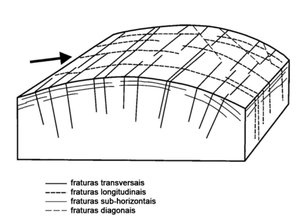
Esq. A - Scheme representing fractures in granite rocks (Migon, 2006).
Location
Sta. Luzia
Coordinates
Lat: 41.7650758
Long: -8.8076562
Hello little one!
I'm Piquinhos and I can help you learn more about the Geopark!
Technical details
Esq. A - Scheme representing fractures in granite rocks (Migon, 2006).
Child Mode
Discover the geopark in a simpler format, aimed at the little ones.
Clique ENTER para pesquisar ou ESC para sair
